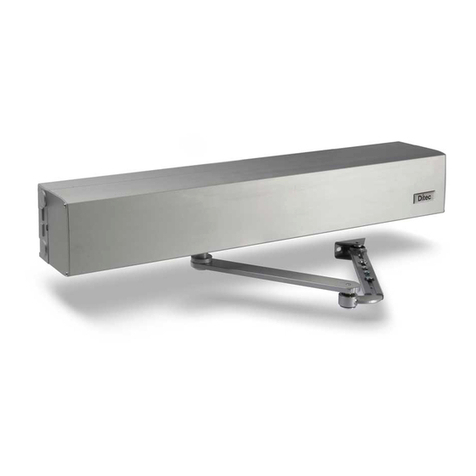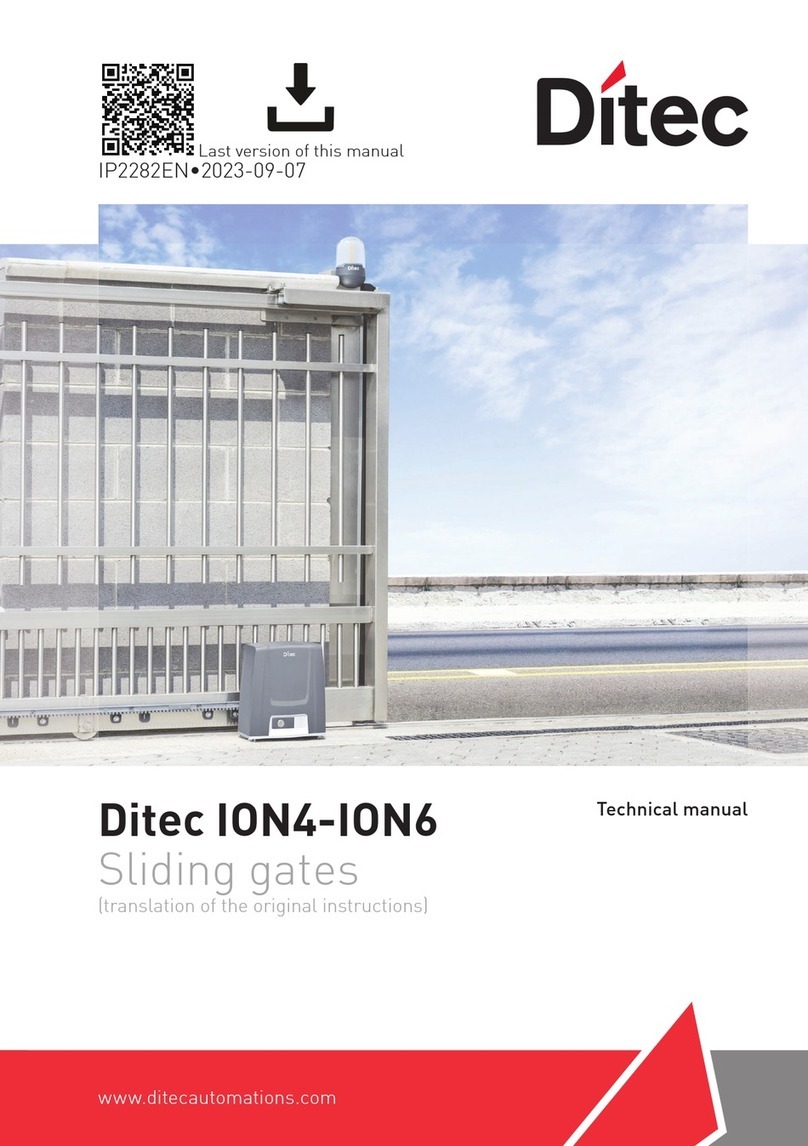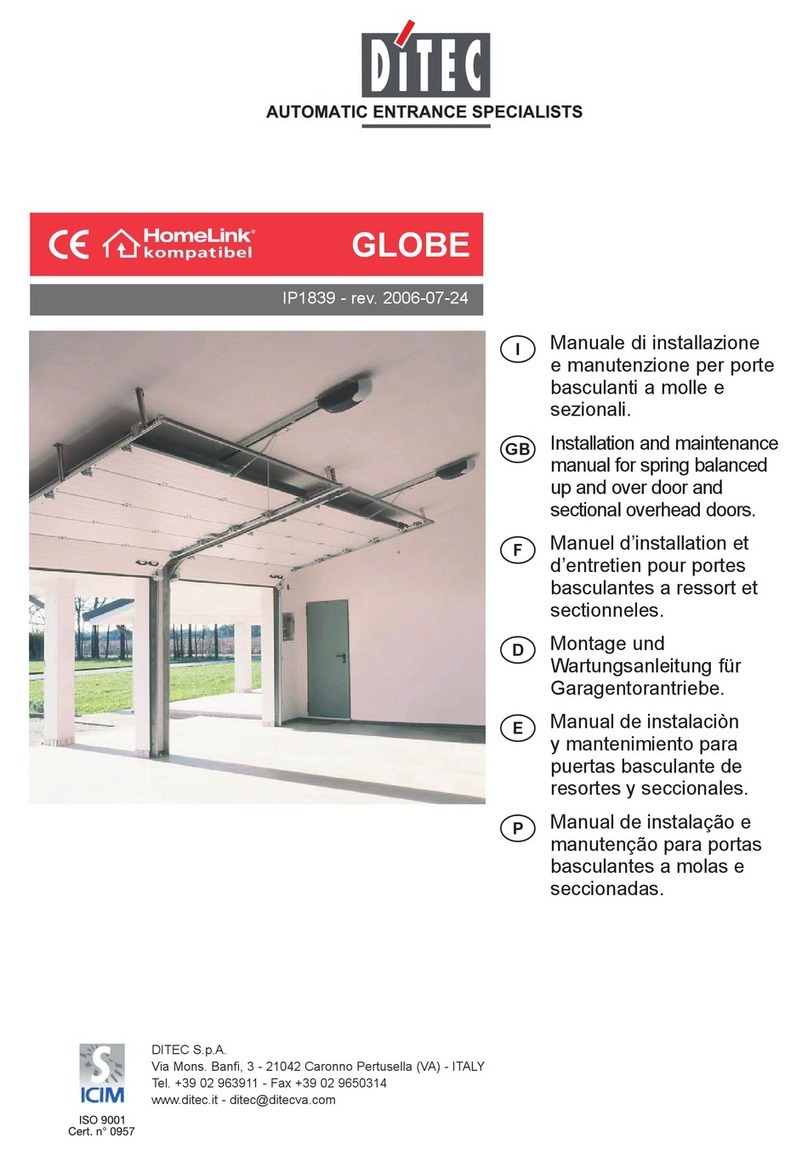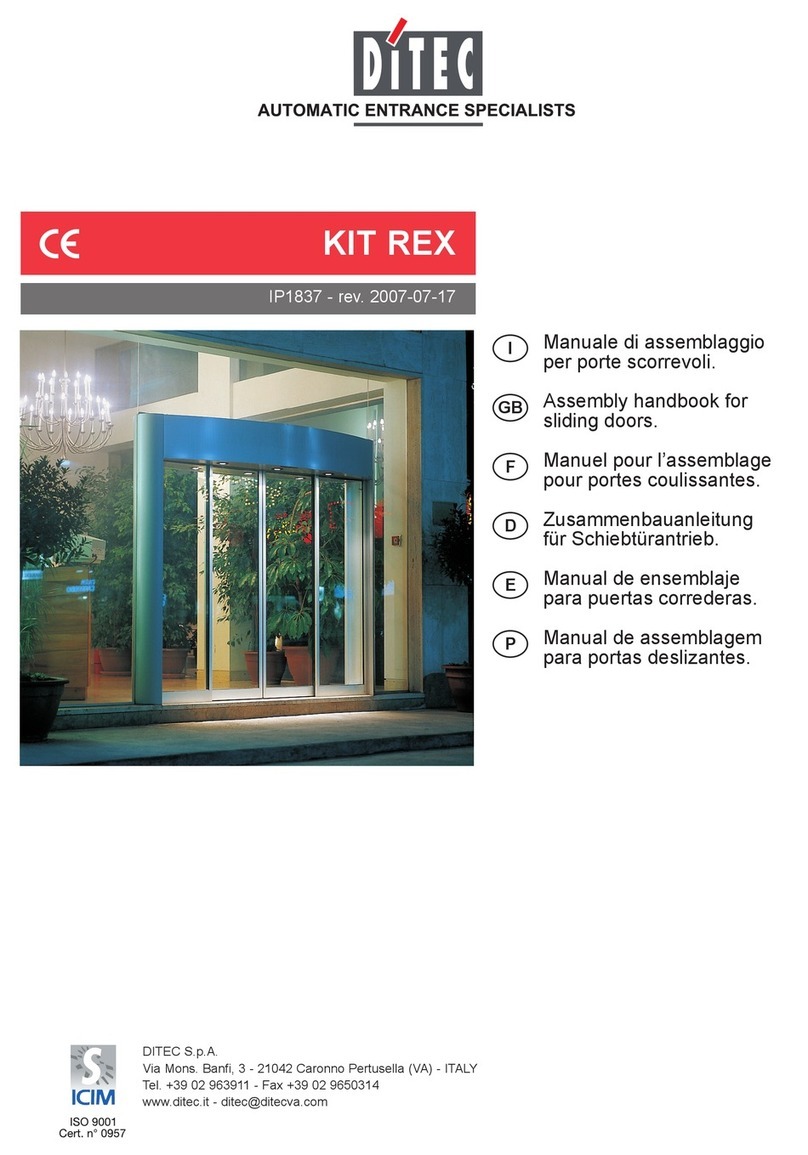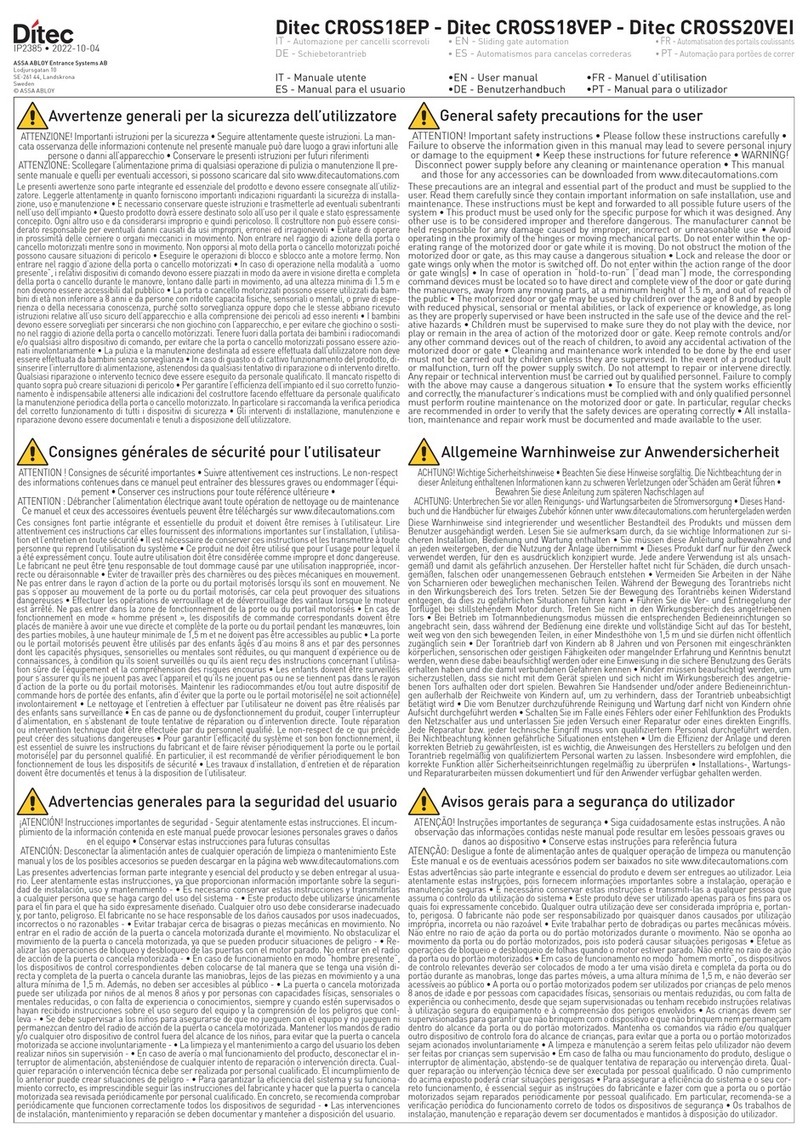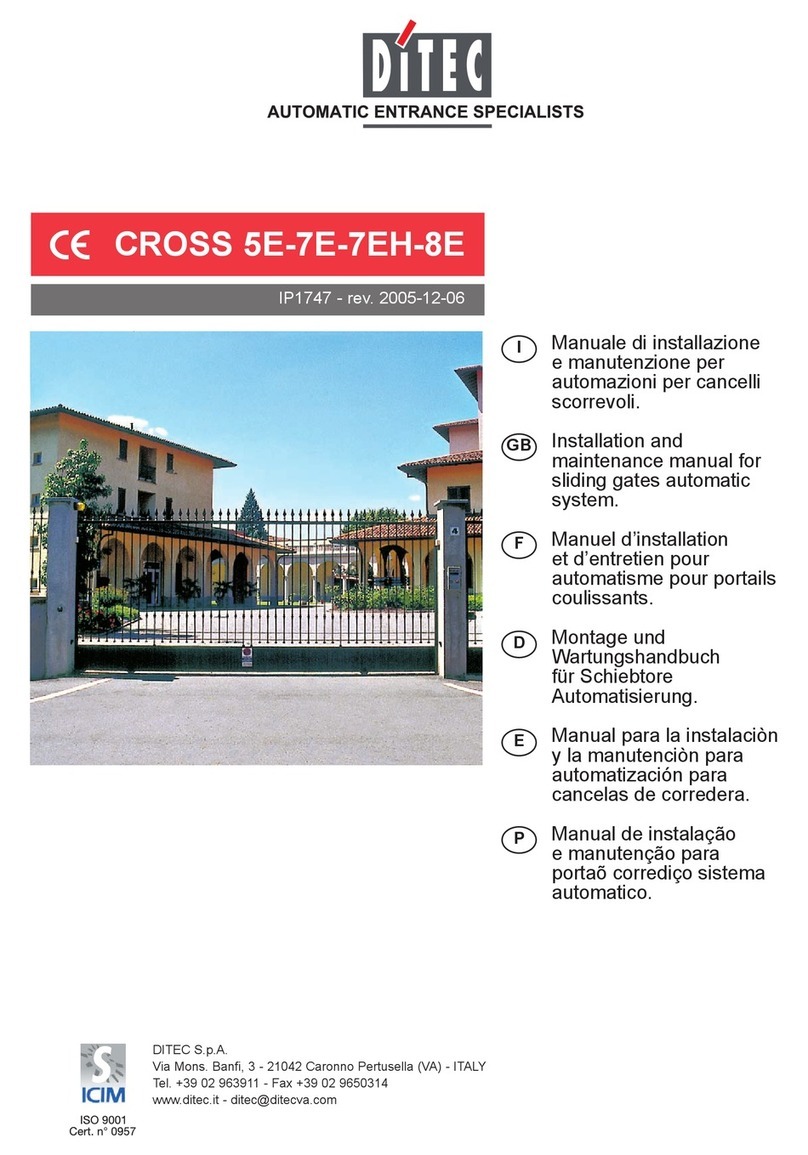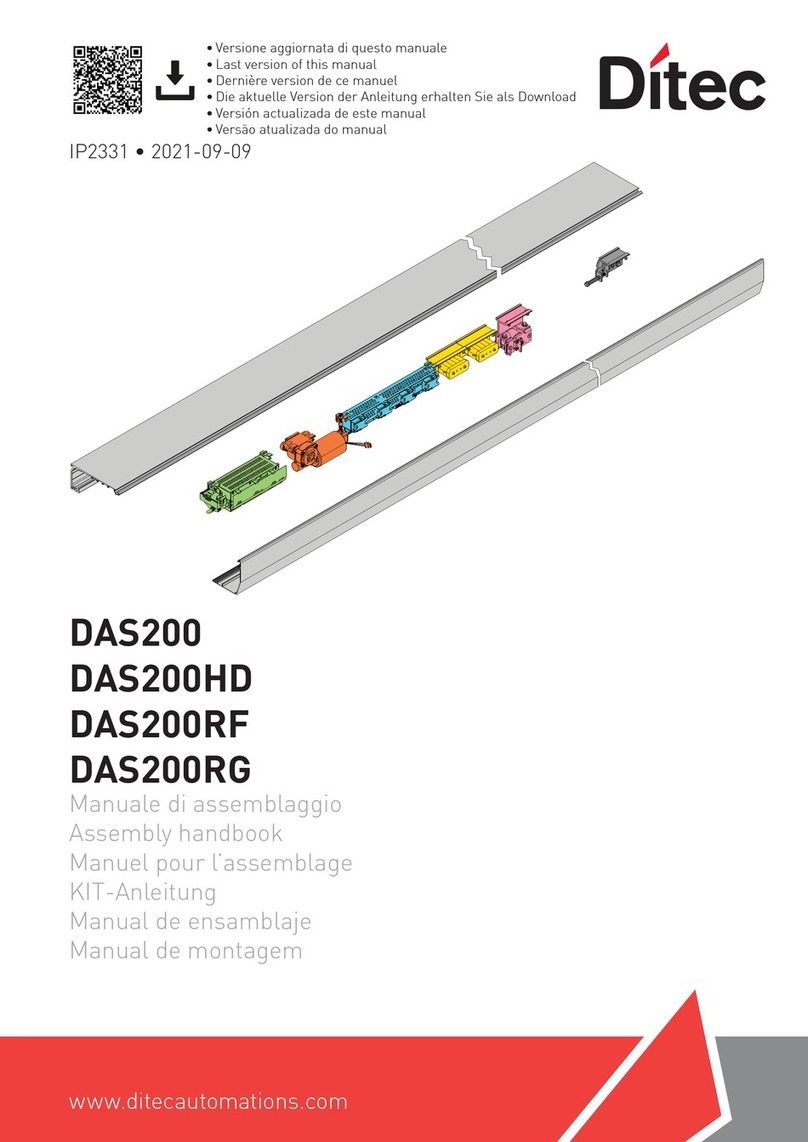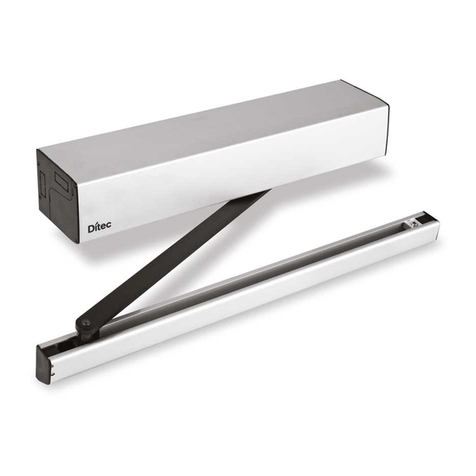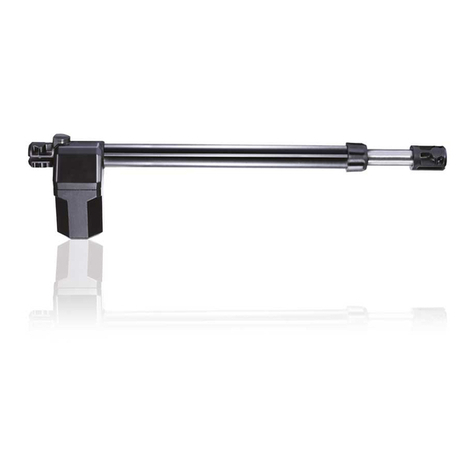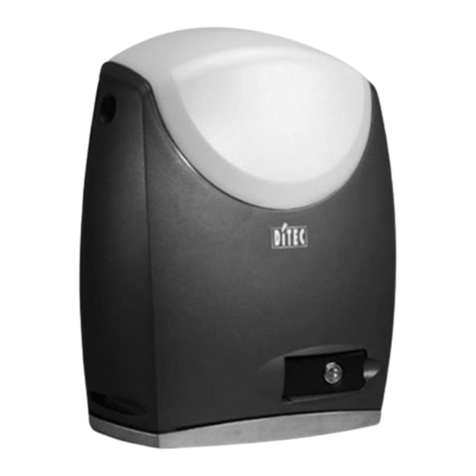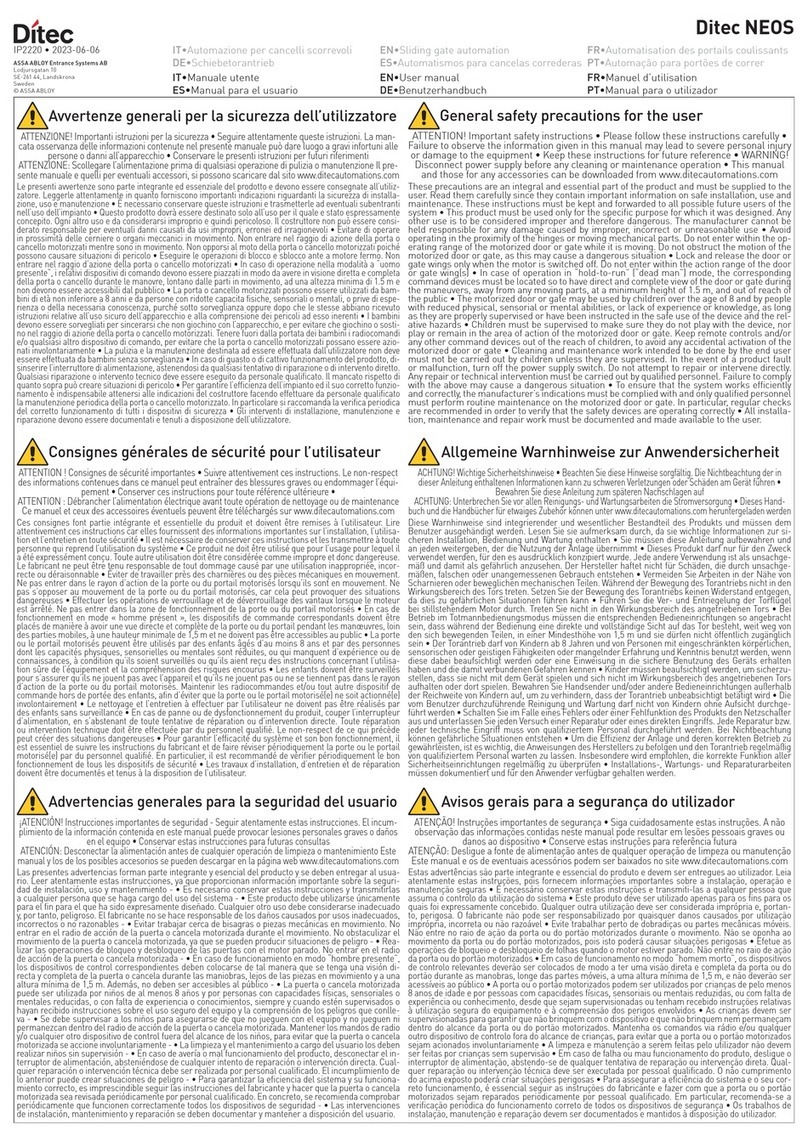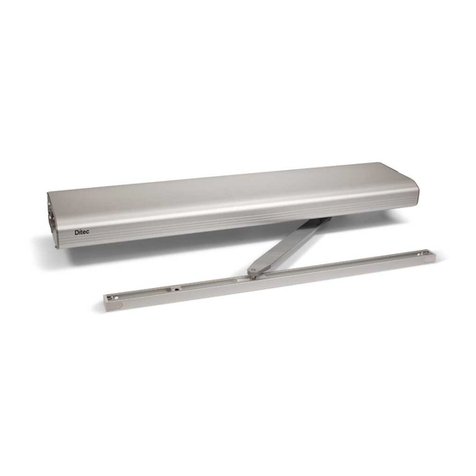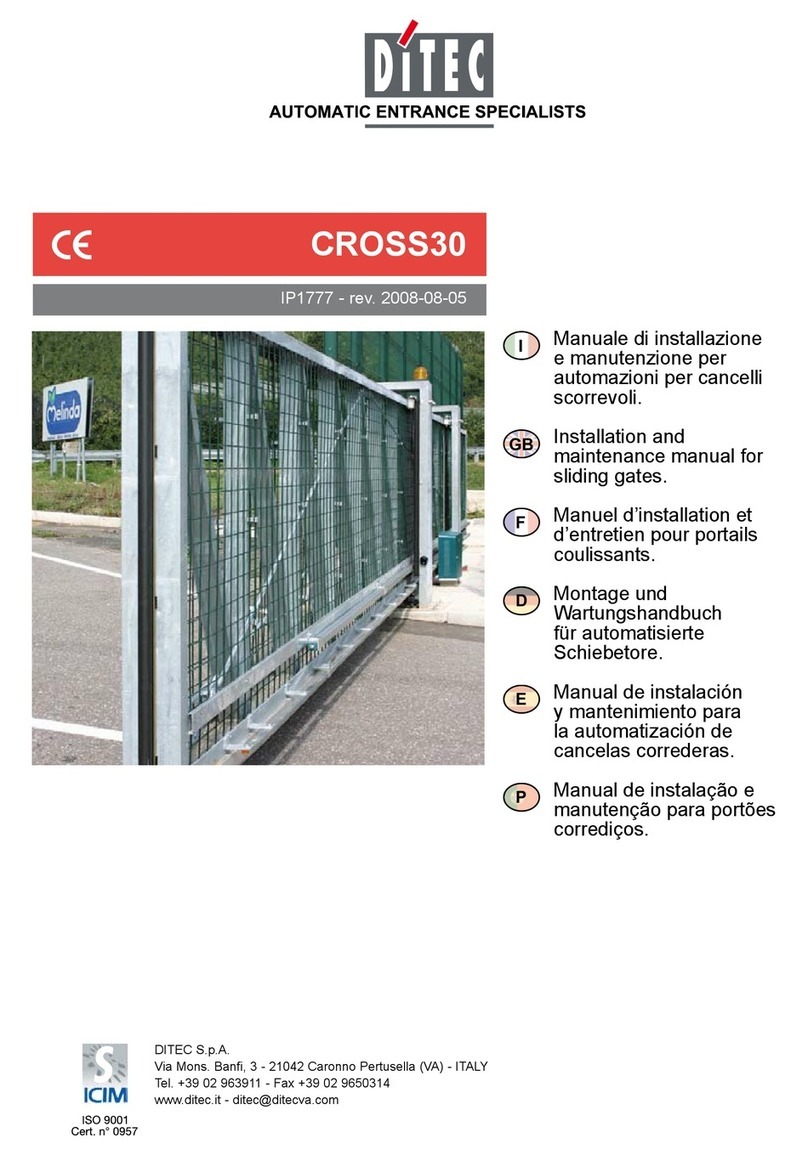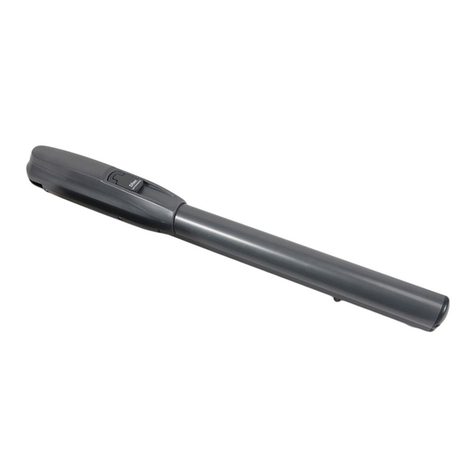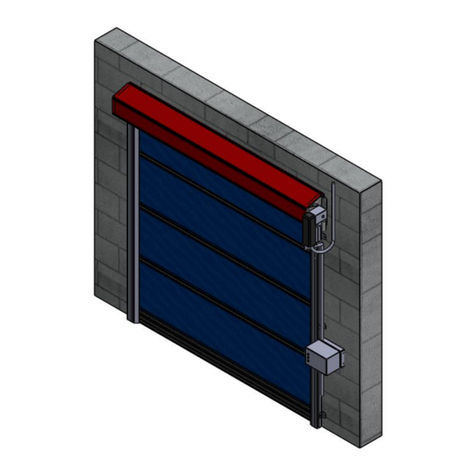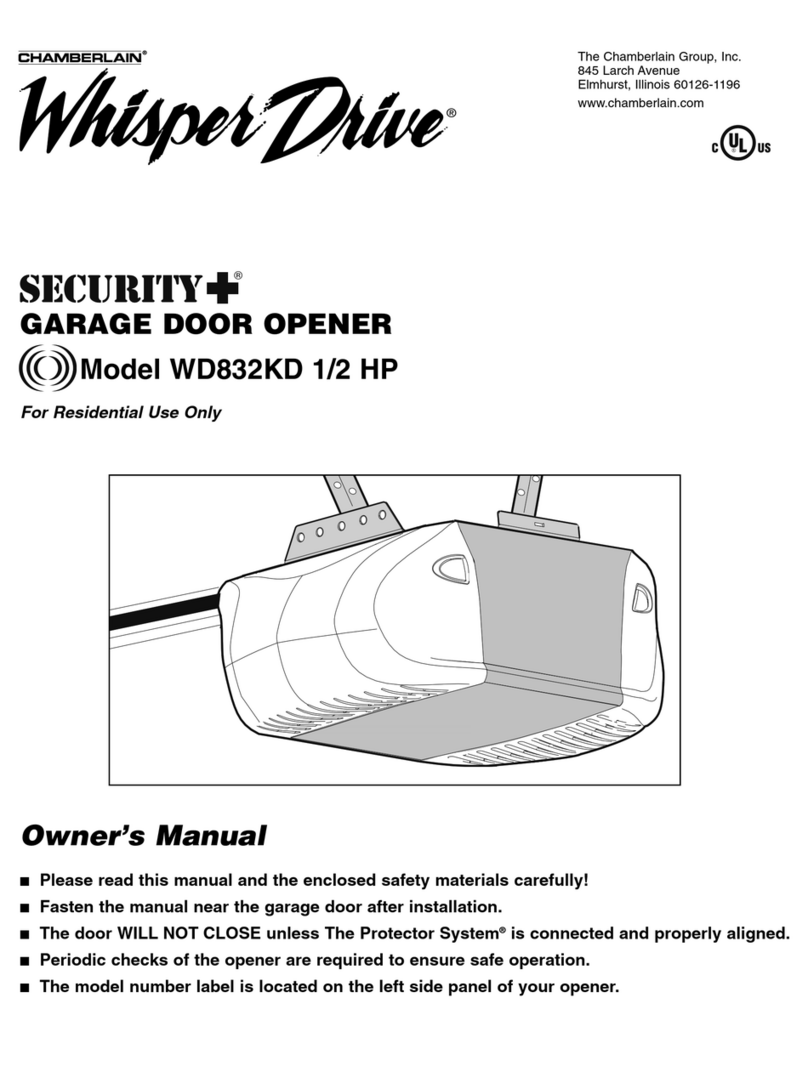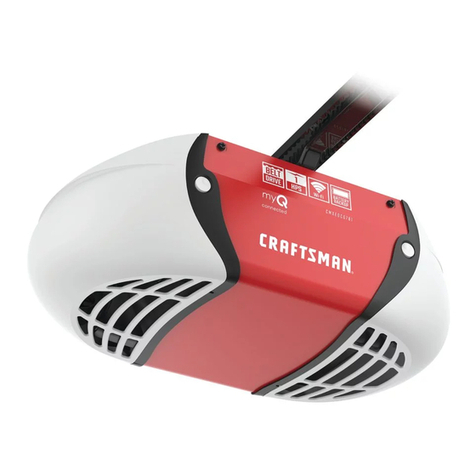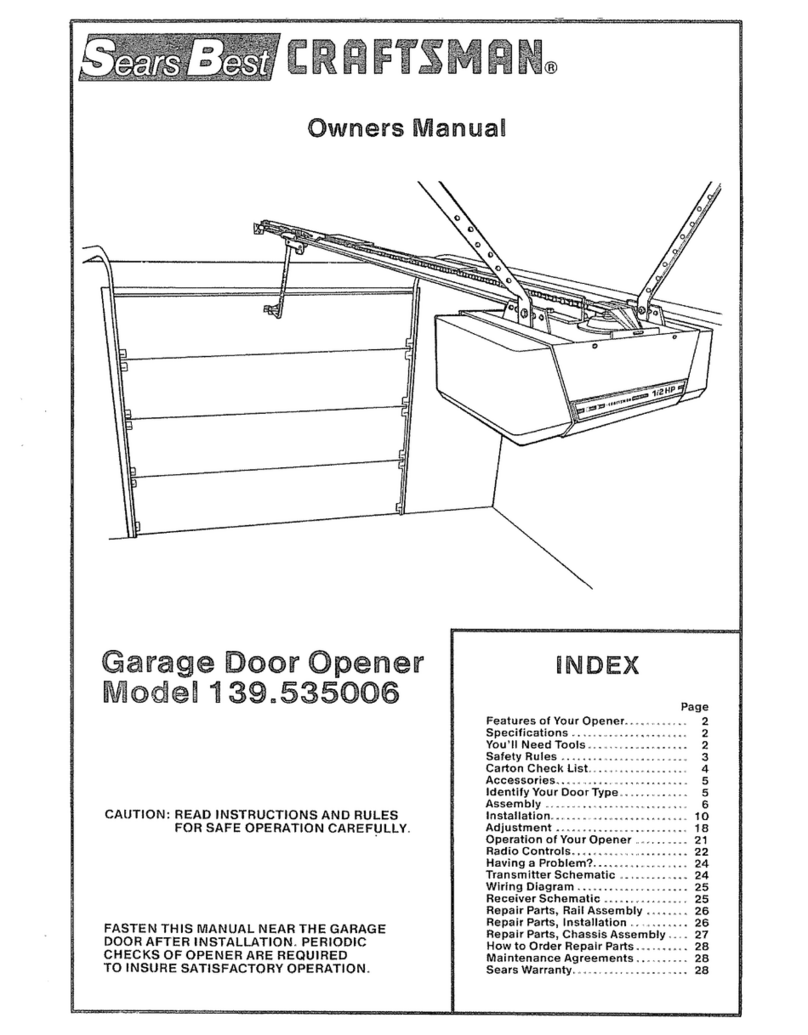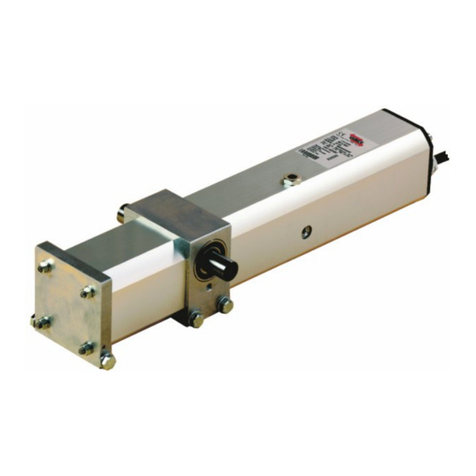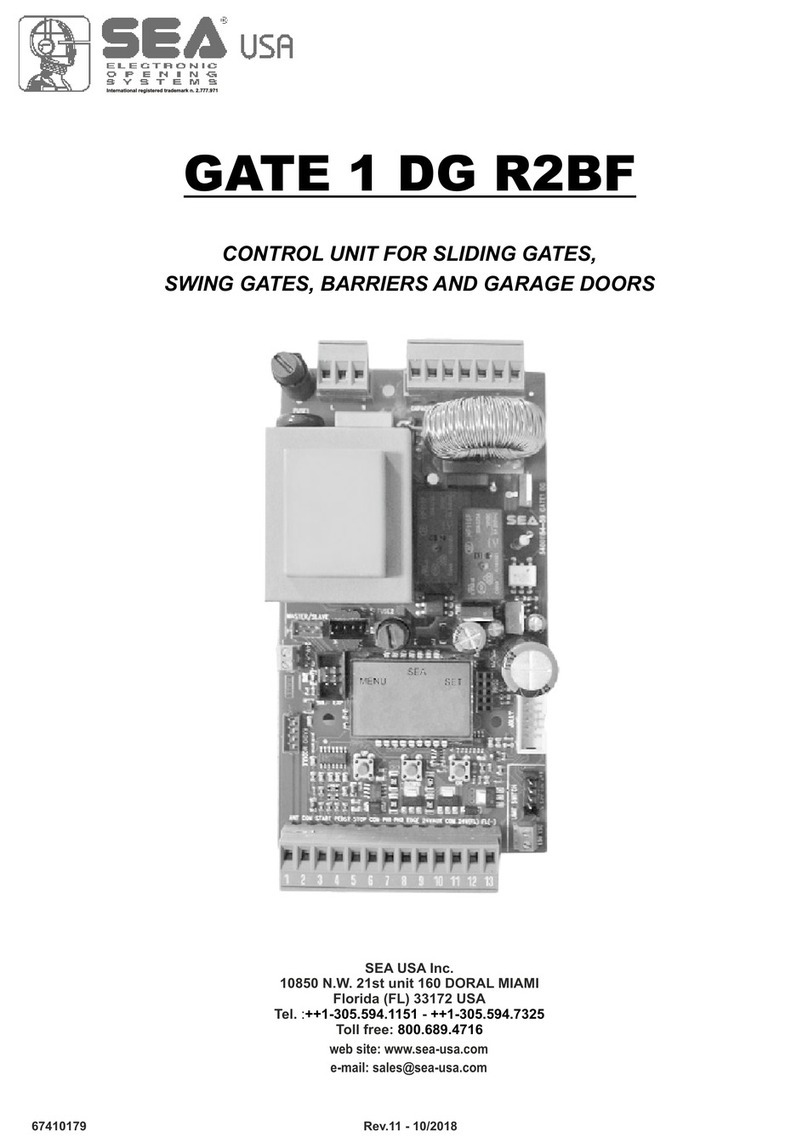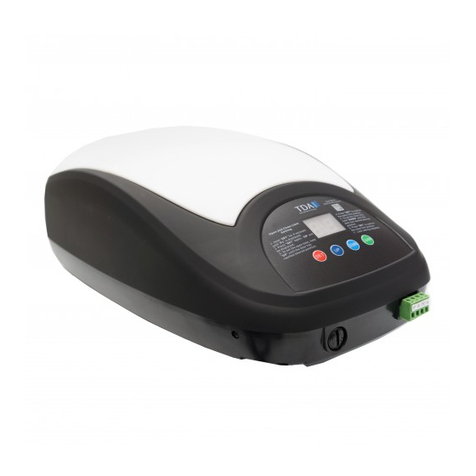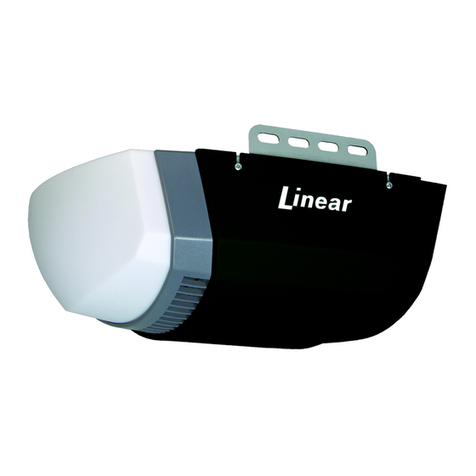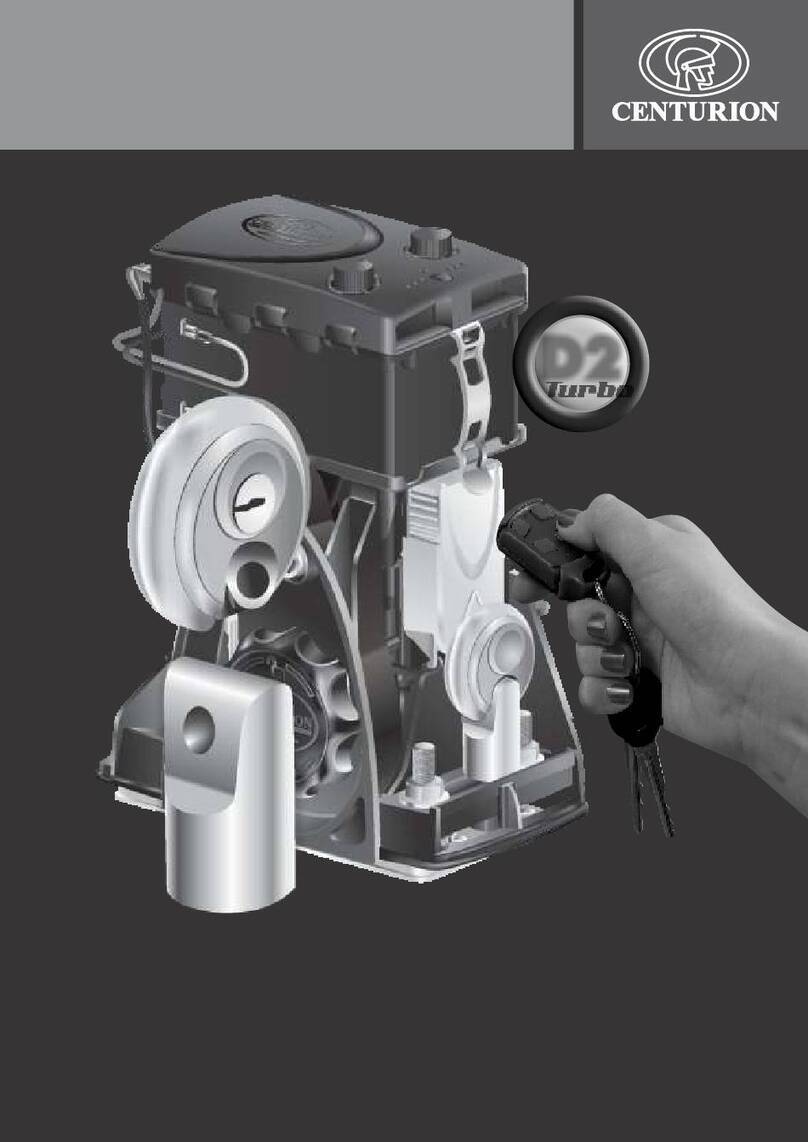DITEC DAS107PLUS User manual

IP2282EN • 2021-03-31
Ditec DAS107PLUS
Automation for
sliding doors
(Translation of the original instructions)
Technical Manual
www.ditecautomations.com

Contents
Key
This symbol indicates instructions or notes regarding safety, to which special atten-
tion must be paid.
This symbol indicates useful information for the correct functioning of the product.
Subject Page
1. General safety precautions 3
Declaration of incorporation of partly completed machinery 4
2. Technical specifications 5
3. Standard installation 6
4. Main components 7
5. Installing the automation 7
5.1 Removing the cover 7
5.2 Fastening of box using supplied wing anchoring brackets 8
5.3 Example with DAS11M8 and DAS18M8 9
5.4 Preparing the glass door wing 10
5.5 Installing and adjusting the door wings 11
5.6 Installing the floor guides 13
5.7 Belt stop installation 13
5.8 Adjusting the belt 14
5.8.1 Type A 14
5.8.2 Type B 14
5.9 Installing the door wing block (optional) 15
6. Electrical connections 15
6.1 Standard electrical connections 16
6.2 Control panel commands 17
6.2.1 Commands 17
7. Adjustment and selection of control functions 19
7.1 Display test 20
7.2 Status indication on the display 20
8. Start up 21
9. Parameters 23
9.1 Configuration parameters according to function 23
9.2 Description of the parameters 25
10. Example of connection 29
10.1 Example of connection with opening radar and photocell 29
10.2 Combined opening and safety sensor + safety sensor on opening 30
11. Troubleshooting / alarms 31
11.1 Alarms 31
12. Routine maintenance plan 35
2
IP2282EN
EN

1. General safety precautions
This assembly and installation manual is intended exclusively for the use of qualified personnel.
Installation, electrical connections and adjustments must be performed by qualified personnel,
in accordance with Good Working Methods and in compliance with the current regulations.
Read the instructions carefully before installing the product.
Incorrect installation could be dangerous.
The packaging materials (plastic, polystyrene, etc.) should not be discarded in the envi-
ronment or left within reach of children, as they are a potential source of danger.
Before installing the product, make sure it is in perfect condition.
Do not install the product in explosive areas and atmospheres: the presence of inflammable
gas or fumes represents a serious safety hazard.
Before installing the motorisation device, make all the necessary structural modifications to
create safety clearance and to guard or isolate all the crushing, shearing, trapping and general
hazardous areas.
Make sure the existing structure is up to standard in terms of strength and stability. The mo-
torisation device manufacturer is not responsible for failure to observe Good Working Methods
when building the frames to be motorised, or for any deformations during use.
The safety devices (photocells, safety edges, emergency stops, etc.) must be installed taking
into account the applicable laws and directives, Good Working Methods, installation premises,
system operating logic and the forces developed by the motorised door or gate.
The safety devices must protect against crushing, cutting, trapping and general danger areas
of the motorised door or gate.
Display the signs required by law to identify hazardous areas.
Each installation must bear a visible indication of the data identifying the motorised door or gate.
When necessary, connect the motorised door or gate to an effective earthing system that
complies with the current safety standards.
During installation, maintenance and repair operations, cut off the power supply before opening
the cover to access the electrical parts.
The automation protection casing must be removed by qualified personnel only.
The electronic parts must be handled using earthed antistatic conductive arms. The man-
ufacturer of the motorisation device declines all responsibility if component parts not
compatible with safe and correct operation are fitted.
Only use original spare parts when repairing or replacing products.
The installer must supply all information concerning the automatic, manual and emergency op-
eration of the motorised door or gate, and must provide the user with the operating instructions.
Failure to respect the information given in this manual
may cause personal injury or damage to the device.
Keep these instructions for future reference
3
IP2282EN
EN

Declaration of incorporation of partly completed
machinery
We:
ASSA ABLOY Entrance System AB
Lodjursgatan 10
SE-261 44 Landskrona
Sweden
declare under our responsibility that the following types of equipment:
Ditec DAS107PLUS Sliding door operator
comply with the following directives:
2014/30/EU Electromagnetic Compatibility Directive (EMCD)
2006/42/EC Machinery Directive (MD) for the following essential health and safety
requirements: 1.1.2, 1.2.1, 1.2.2, 1.2.3, 1.2.4.2, 1.2.6, 1.3.9, 1.4.3, 1.7.2, 1.7.4,
1.7.4.1, 1.7.4.2
2011/65/EU on the restriction of the use of certain hazardous substances in electrical
and electronic equipment (RoHS).
Technical documentation for safe integration supplied.
Harmonised European standards which have been applied:
EN 60335 -1:2012+A13:2017 EN ISO 13849 -1:2015 EN 61000 -6-2:2005
EN 60335-2-103:2015 EN 16005:2012/AC:2015 EN 61000 -6-3:2007+A1:2011
Other standards or technical specifications, which have been applied:
IEC 60335-1: 2010 ed.5 IEC 60335-2-103:2006+A1:2010 DIN 18650-1:2010
CE type examination or certificate issued by a notified or competent body for the equipment:
TÜV SÜD B 085479 0008
The production process aims to guarantee that the equipment complies with the technical
documentation.
The equipment must not be put into service until the final door system installed has been
declared compliant with the Machinery Directive 2006/42/EC by the installer.
Person in charge of technical data sheet:
Matteo Fino
Business Area PGA
Ditec S.p.A.
Largo U. Boccioni, 1 - 21040 Origgio (VA) - Italy
Signed for and on behalf of ASSA ABLOY Entrance System AB by:
Place Date Signature Position
Origgio 2021-03-26 Matteo Fino President B.A. PGA
g
Mat
M
Mat
Mat
Mat
Mat
Mat
Mat
Mat
Ma
Mat
Mat
Mat
Mat
Mat
M
Mat
Mat
Mat
Mat
Mat
t
Mat
Mat
Mat
t
M
t
t
t
t
M
at
t
M
teo
t
t
t
t
t
t
t
t
t
t
t
t
t
t
t
t
t
t
Fi
no
no
n
n
no
no
no
n
n
n
no
no
no
n
n
n
n
n
n
n
n
n
n
n
n
n
n
n
n
4
IP2282EN
EN

2. Technical specifications
Power supply 100V~ / 240V~ 50/60Hz
Rated power 75W
Opening speed (2 door wings) 1m/s
Closing speed (2 door wings) 1m/s
Maximum load 120kg (1 door wing)
160kg (2 door wing)
Intermittence S3=100%
Temperature -20°C +50°C
Degree of protection IP20
(FOR INTERNAL USE ONLY)
Power supply for accessories 24V 0,64A
Durability test 1.000.000 cycles
5
IP2282EN
EN

3. Standard installation
Ref. Description
1Automation for sliding doors
2
3Combined opening and safe closing sensor
4Safe opening sensor
5Safety photocell
6Function selector switch
AConnect the power supply cable to a type-approved omnipolar switch with category III insulation and
a contact opening distance of at least 3mm.
The connections to the mains and low voltage wires must be made on an independent channel sep-
arated from the connections to the command and safety devices (SELV = Safety Extra Low Voltage).
1
32
5
A
6
4
4
6
IP2282EN
EN

4. Main components
Ref. Code Description
7Mains power supply
8 1DAS1ALP 75W power supply unit
9 1DAS1MR Gearmotor
10 1DAS1QEP Control panel
11 DAS901BAT1
DAS902BAT2
12V batteries (optional), set parameter 43= 05
24V batteries (optional - the fuse in the cable harness is T10A)
12 Drive belt
13 Belt transmission
14 DAS801LOK
DAS801LOKA
Lock with external lock release lever
Anti-panic lock
NOTE: the given operating and performance features can only be guaranteed with the
use of DITEC accessories and safety devices.
8910 11 12 13
714
5. Installing the automation
5.1 Removing the cover
Loosen screw C to free the cover supports and lift the cover to remove it.
BA
B
C
A
7
IP2282EN
EN

5.2 Fastening of box using supplied wing anchoring brackets
Unless otherwise specified, all measurements are expressed in millimetres (mm).
The figure shows the measurements for fastening the DAS107PLUS automation to the wall, con-
sidering that the automation door wings are made using profiles not manufactured by us.
If the door wings are made with DITEC profiles in the ALU/PAM series: refer to the measurements
given in the relative manuals.
Drill a hole in the box using the reference line on the back and fasten it with M6 Ø12 steel plugs
or 6MA screws (not supplied).
Distribute the fixing points approx. every 400mm.
Make sure the box is positioned evenly, with its back surface perpendicular to the floor and not
deformed lengthwise by the shape of the wall. If the wall is not straight and smooth, iron plates
must be fixed to it and then the box in turn fixed to the plates.
WARNING: the fastening of the box to the wall must be sufficient to sustain the door wing weight.
WARNING: do not damage the wheel guide during assembly. Clean the guide thoroughly before
installing the wings.
H
HM=H-44
10
+/- 19
+/- 8
0KP515AB
35
143
120
303419
50
80
12
2995
DAS107PLUS-AI2995
8
IP2282EN
EN

5.3 Example with DAS11M8 and DAS18M8
3530
34
22 25
120
143
+/- 8
DAS18M8
AC4255
3530
120
143
1841
34
+/- 8
DAS11M8
AC1356
DAS107PLUS-AC1356
DAS107PLUS-AC4255
9
IP2282EN
EN

Ø10 Ø10 Ø10
100
100100
100
L≤1000
L≤1000
11
11
100 100 100 100
L>1000
Ø15
Ø15
30 30
100100
3030
L≤1000
Ø15
L>1000
L>1000
100 100 100 100
100 100 100 100
10
12
Ø15 Ø15
Ø15
5.4 Preparing the glass door wing
The diagram indicates the process measurements of the AC1356 aluminium profile and glass.
Ø10 through holes are required on the aluminium profile and Ø15 on the glass for fastening. The
number of holes and related distance between centres are based on the door wing width. Silicon
should ideally be used between the edge of the glass and the internal base of the profile.
For applications with an AC4255 or AC4870 glass door wing attachment, refer to the
relevant manual.
10
IP2282EN
EN

5.5 Installing and adjusting the door wings
WARNING: after door leaves installation and adjustment REMOVE ALL THE CAR-
RIAGE SELF SUPPORT BRACKETS (K).
H
+/- 8
+/- 19
K
J
I
J
Fix the door wing to the carriage with screws [J].
The door wing can be adjusted as shown in the figure.
• loosen the screws [H] and adjust the height by turning the screws [I];
• adjust the side position of the door wing by turning the screws [J];
• move the door wings manually and make sure they move smoothly and freely and that all
the wheels rest on the guide.
WARNING: for all-glass door wings without seals, leave a gap of at least 10 mm in the closed
position to avoid contact between the glass sheets.
130
130
130
130
OPEN OPEN
AUTOMATION WITH TWO DOOR WINGS
11
IP2282EN
EN

• Place the end stops [E] on the opening and closing positions.
• For the 2 wing automations, a third end stop is provided which must be placed near the end
of the box which is used as a stop for the cover support.
E
E
180
OPEN
OPEN
130
130
180
AUTOMATION WITH ONE DOOR WING WITH
RIGHT-HAND OPENING
AUTOMATION WITH ONE DOOR WING WITH
LEFT-HAND OPENING
12
IP2282EN
EN

KAMC16KP369
KP515AB
KP48
K4345
50 min 21
max 40
10
22
10
HM
46
5.6 Installing the floor guides
The floor guides must be made of an anti-friction material such as PVC, NYLON or TEFLON.
The length of the floor guide should be no greater than the overlap between the fixed and mobile
door wings, and should not enter the passage opening.
Examples of floor guides
5.7 Belt stop installation
13
IP2282EN
EN

5.8.2 Type B
LT ≤ 3000 = 2 mm
LT > 3000 = 3 mm
16
5
24
4
5
2
3
5.8 Adjusting the belt
I
I
I
I
I
I
I
I
I
I
I
I
I
I
I
I
I
I
LT ≤ 3000 = 0,9 N m
LT > 3000 = 1,1 N m
FFG
13
2
The belt tension is factory-adjusted and readjustment is normally not needed. If despite this, the
belt tension has to be corrected, proceed as follows:
5.8.1 Type A
a) Loosen the two fixing screws (F).
b) Tighten the belt adjustment screw (G), M6 ,to a torque of 0,9 / 1,1Nm.
c) Tighten the two fixing screws (F).
WARNING: incorrect adjustment impairs the correct functioning of the automation.
14
IP2282EN
EN

5.9 Installing the door wing block (optional)
A blocking device can be installed to keep the door wings closed.
The control panel automatically recognises the type of block installed.
For installation, refer to the blocking device installation manual.
6. Electrical connections
Connect the automation to an efficient earthing system that complies with current safety
standards.
During installation, maintenance and repair operations, cut off the power supply before opening
the cover to access the electrical parts.
The automation protection casing must be removed by qualified personnel only.
An omnipolar disconnection switch with a contact opening distance of at least 3 mm must be fitted
on the mains supply.
Check there is an adequate residual current circuit breaker and overcurrent cutout upstream of
the electrical system.
Install an electric switch next to the automatic system.
Make sure there are no sharp edges that may damage the power supply cable.
If the power cable is damaged, have it replaced by the manufacturer or qualified personnel.
• Use a H05RN-F 3G1,5 or H05RR-F 3G1,5 type electric cable.
• Remove the protective cover [1].
• Connect the power cable [2] to the terminal board [4], locking it in place with the cable fastener [3].
• Replace the protective cover [1].
• Connect the connection cable [5] to the power supply unit [6].
LN
2
3
4
5
5
6
1
15
IP2282EN
EN

6.1 Standard electrical connections
Output Description
A
Power supply unit connection
B
Motor connection
C
Encoder connection
DO NOT USE
green LED
D
Used for connection of 1 selector COM501MHS/COM501MKS/ COM500ES.
Green LED: If this LED is switched off or flashing, it means the control
panel is malfunctioning;
E
DAS901BAT1 - DAS902BAT2 battery kit connection (optional)
In the event of a power failure the operator will carry out an opening op-
eration ( factory setting).
See parameters 10, 38, 41and 43 for selection and monitoring.
NOTE: Monitoring will be made if parameter 10 is set to Convenience
Monitoring (01).
WARNING: for charging purposes, the battery kit must be connected to
the control panel at all times.
Periodically check the efficiency of the battery kit.
When there is no voltage, the door can only be opened with a KEY command
connected between 8-12.
NOTE: use battery type 12V, 1,2Ah NiMH.
If a different type of battery is used it can damage!
NOTE: DAS902BAT2: the fuse in the cable harness is T10A
B
C
A1DAS1QEP
1DAS1MR
DAS902BAT2 (24 V) (optional)
DAS901BAT1 (12 V)
(optional)
1DAS1ALP
E
D
DAS902BAT2: the fuse in the
cable harness is T10A
16
IP2282EN
EN

6.2 Control panel commands
7
6
5
4
3
2
1
14
13
12
11
10
9
8
17
16
15
20
19
18
DO NOT USE
Blocking device
Blocking device
(+) 24 V
Inner side opening
(-) 0 V
(+) 24 V
Central presence sensor test
Key opening
Safety photocell 2 or central presence sensor 2
DO NOT USE
Safety photocell 1 or central presence sensor 1
(-) 0 V
(+) 24 V
Side presence sensor test
Outer side opening
Side presence sensor 2
Stop
Side presence sensor 1
Jumper the unused N.C. contacts
(-) 0 V
blocking device connection
}
(use this contact
if used only
one sensor)
(use this contact
if used only
one sensor)
NOTE: Power supply output for exter-
nal accessories 24V 0,64A.
The maximum absorption of 0,64A
corresponds to the sum of all termi-
nals power supply output (1-7; 8-14;
15-17)
6.2.1 Commands
Contact Description
1 2
(ref. parameter 27)
N.C. SIDE PRES-
ENCE SENSOR 1
Connect side presence sensor 1 as shown in the examples in par-
agraph 10.2.
1 3
(ref. parameter 46)
N.C. STOP The opening of the safety contact causes the current operation
to stop.
WARNING: when the contact closes again, the door closes.
WARNING:
The emergency opening (battery 12V), is priority ( = door
opens in case of mains power failure even if STOP contact is open).
1 4
(ref. parameter 28)
N.C. SIDE PRES-
ENCE SENSOR 2
Connect side presence sensor 2 as shown in the examples in par-
agraph 10.2.
1 5
N.O. OUTER SIDE
OPENING
Connect the external sensor as shown in the examples in para-
graphs 10.1 and 10.2.
The closure of the contact activates the door opening operation.
6
(ref. parameter 29)
SIDE PRES-
ENCE SENSOR
TEST
Connect the test clamp of the side sensors.
Clamp 6 activates a test on the side safety sensors before every op-
eration. If the test fails, an alarm message appears on the display.
The door will open and remain open until the fault is cleared.
1 -
7 +
POWER SUPPLY
TO ACCESSO-
RIES
24V accessories power supply.
17
IP2282EN
EN

Contact Description
8 9
(ref. parameter 07)
N.C. SAFETY PHO-
TOCELL 1 OR
CENTRAL
PRESENCE
SENSOR 1
Connect safety photocell 1 or central presence sensor 1 as shown
in the examples in paragraphs 10.1 and 10.2.
8 11
(ref. parameter 08)
N.C. SAFETY
PHOTOCELL 2
OR CENTRAL
PRESENCE
SENSOR 2
Connect safety photocell 2 or central presence sensor 2 as shown
in the examples in paragraphs 10.1 and 10.2.
8 12
(ref. parameter 04)
N.O. KEY OPENING Closing the contact via a key command activates an opening oper-
ation and a closing operation after the time selected by parameter
04.
If used for opening in DOOR CLOSED mode:
- In the presence of a mains power supply or continuity batter-
ies, a 8-12 command partially opens the door and closes it
after the time selected by parameter 04.
- If there is no mains power supply, a 8-12 command reactivates
the batteries, if present, for the time required to perform a
complete opening operation and then the batteries are dis-
connected from the control panel.
13
(ref. parameter 09)
CENTRAL
PRESENCE
SENSOR TEST
Connect the test clamp of the presence sensors.
Command 13 activates a test on the central safety sensors before
every operation. If the test fails, an alarm message appears on
the display.
The door will open and remain open until the fault is cleared.
8 -
14 +
POWER SUPPLY
TO ACCESSO-
RIES
24V accessories power supply.
Contact Description
15 16 N.O. INNER SIDE
OPENING
Connect the internal sensor as shown in the examples in para-
graphs 10.1 and 10.2.
The closure of the contact activates the door opening operation.
15 -
17 +
POWER SUPPLY
TO ACCESSO-
RIES
24V accessories power supply.
Contact Description
18 19
(ref. parameter 05)
BLOCKING
DEVICE
CONNECTION
Output for connecting an electro-mechanical block (optional).
The blocking device is automatically selected during the learning phase.
18
IP2282EN
EN

7. Adjustment and selection of control functions
The control panel has a two-figure display that displays text and/or numbers.
It has four buttons.
1
2
3
4
LEARN / EXIT SELECT
UP
DOWN
LEARN / EXIT
UP
SELECT
DOWN
The procedure to switch on the display is as follows:
press the 2-SELECT key to launch the display test
NOTE: make sure all seven segments of the two displays light up correctly to avoid incorrect reading.
- 1 UP: to increase the parameter number or value in it;
- 2 SELECT: to enter a parameter or value to be programmed in the memory;
- 3 DOWN: to decrease the parameter number or value in it;
- 4 LEAR/EXIT:
• LEARN has 3 functions: 1, 2, 3.
1. Quick learning. If pressed for longer than 1 second but less than 2, the electronic
accessories connected to the control board are recognised.
2. Normal learning. If pressed for longer than 2 seconds, the display flashes . Two
seconds after releasing the button, a complete learning cycle begins which performs an
opening and closing operation to carry out the operations described in chapter 8.
3. Restore factory settings. If pressed for longer than 10 seconds, the control panel re-
stores the factory settings .
• EXIT quits the parameter menu or value without saving the changes. If EXIT is not
pressed, the control panel returns to the default display after 3 minutes of inactivity.
NOTE: the set value is stored by the control panel by pressing SELECT irrespective of whether the
value has been modified or not. Press EXIT if you do not want to store the value.
When a value is programmed, that parameter is excluded from the learning cycle. Even if a new
learning cycle is executed, that value will not be modified.
To include the parameters in the learning cycle again, the factory settings must be set.
19
IP2282EN
EN

Display Char
acter Display Char
acter Display Char
acter Display Char
acter Display Char
acter
7.1 Display test
a. When the display shows " ", push the SELECT button and each of the two display win-
dows make a rotating test pattern.
b. Verify that all seven segments of the two display windows are lit during the test. If not there is
a risk of misjudgment of the digits shown in a defective display.
c. When the display test is finalized the display shows two steady digits indicating the first parameter.
7.2 Status indication on the display
The display shows the different impulses that are active. The status viewing starts with showing “ ”
as for Status, then one or many numbers representing the different active impulses in to the operator.
The different impulses are:
00= Key Impulse
01= Inner impulse
02= Outer impulse
03= Synchronisation (not used)
04= Interlock in impulse (not used)
05= Presence impulse 1
06= Presence impulse 2
07= Side Presence impulse 1
08= Side Presence impulse 2
09= Stop impulse
10= Emergency open impulse (not used)
13= Close command
14= Nurse impulse (not used)
24= Push and Go impulse
25= Open-Close impulse
28= Fire impulse (not used)
47= Interlock Disable (not used)
20
IP2282EN
EN
Other manuals for DAS107PLUS
3
This manual suits for next models
3
Table of contents
Other DITEC Garage Door Opener manuals
Popular Garage Door Opener manuals by other brands
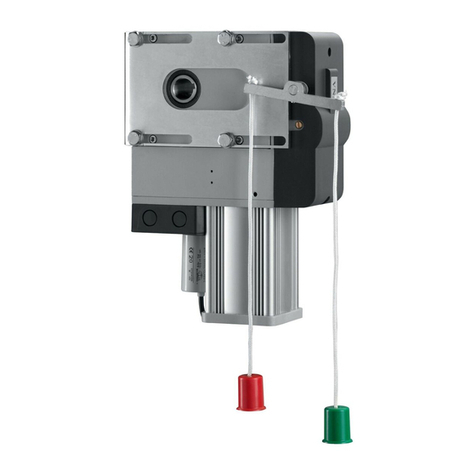
Beninca
Beninca VN.S40E manual

Motorline professional
Motorline professional KVM2020 installer and user manual
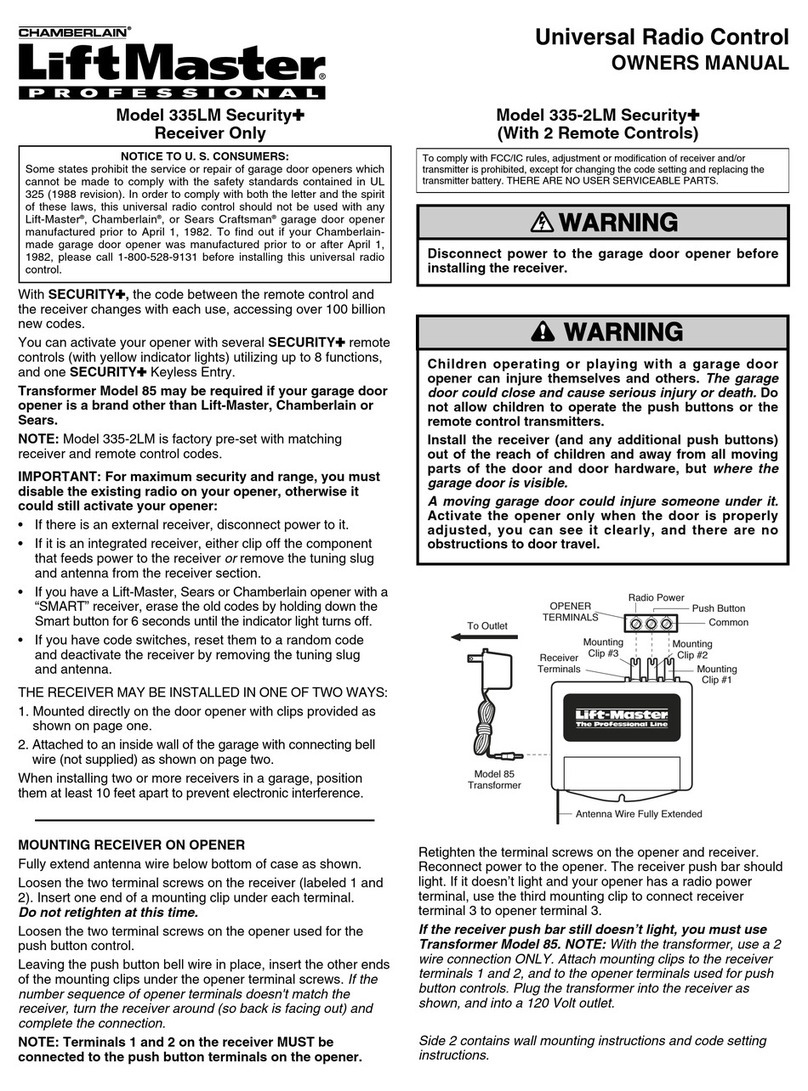
Chamberlain
Chamberlain LiftMaster 335LM Security+ owner's manual
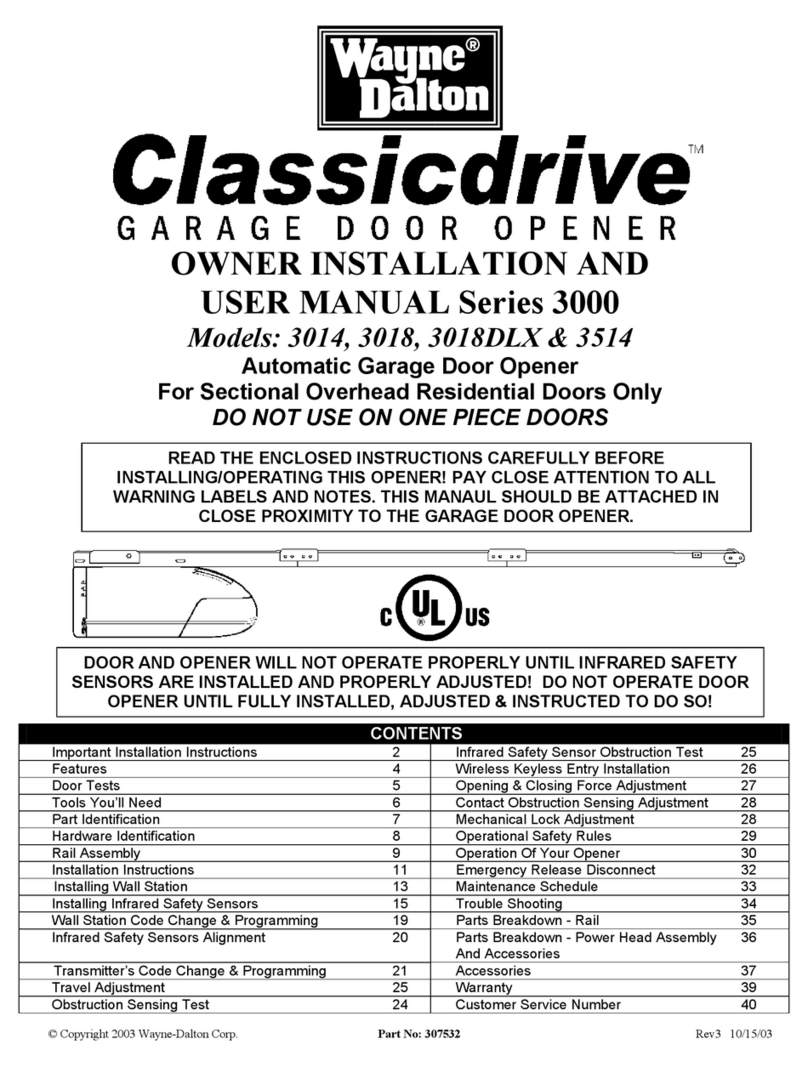
Wayne
Wayne Classicdrive 3014 Owner installation and user manual
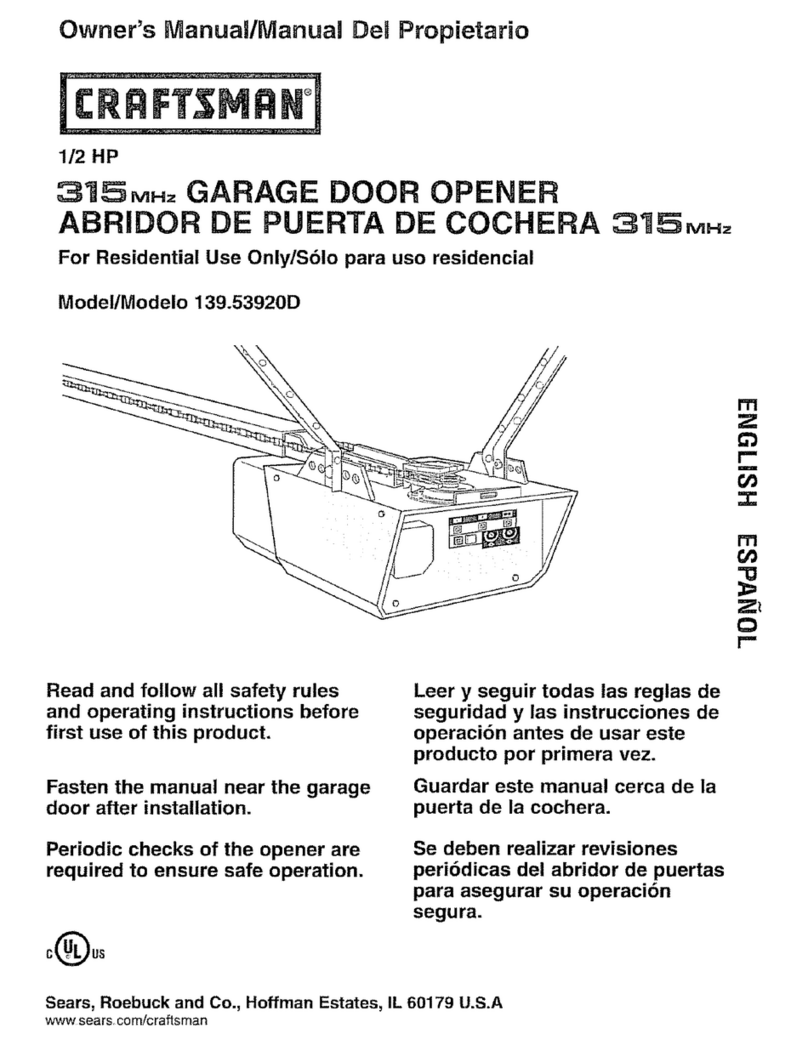
Craftsman
Craftsman 139.53920D owner's manual
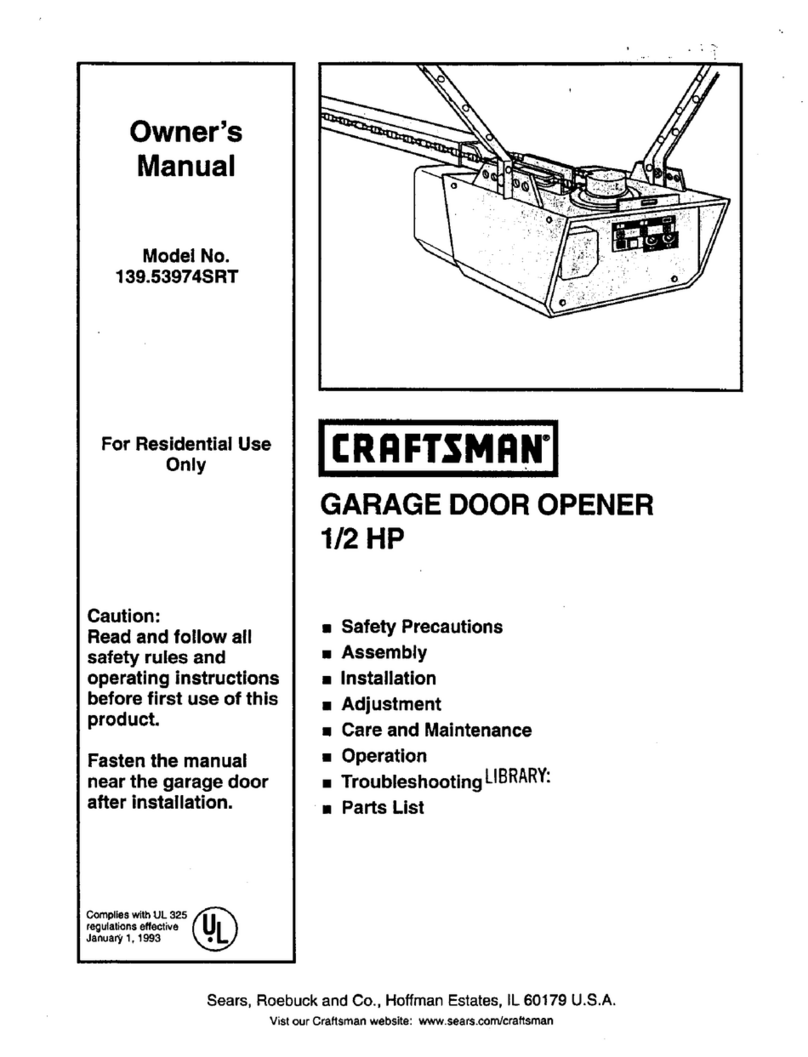
Craftsman
Craftsman 139.53974SRT owner's manual
